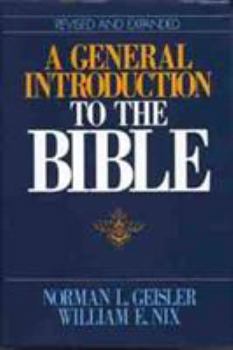A General Introduction to the Bible
Select Format
Select Condition 
Book Overview
This book is about the Bible--the most important book that has existed in the history of the world. As you turn the pages of this revised and expanded edition, you will discover how to navigate the Bible with careful scholarship. You will gain key insights such as:
The...
Format:Hardcover
Language:English
ISBN:0802429165
ISBN13:9780802429162
Release Date:August 1986
Publisher:Moody Publishers
Length:728 Pages
Weight:2.45 lbs.
Dimensions:1.7" x 6.3" x 9.2"
Customer Reviews
5 ratings
Don't be Fooled by the title
Published by Thriftbooks.com User , 19 years ago
This book claims to be a general introduction of the bible. It is general in the sense in cover everything in general about how the bible was put together. It has nothing to do with the bible doctrines but with the canon.
A Lot of Helpful insights
Published by Thriftbooks.com User , 22 years ago
This book has a lot of helpful insight on the history of how we got our Bible. Of course the book is not in favour of the Textus Receptus/KJV, however the information found in this book concerning Canonization, and Inspiration is good.
Instructive reference text
Published by Thriftbooks.com User , 23 years ago
A great one volume work on the inspiration, canonization, transmission and translation of the Bible. There are also good B & W photos, e.g. the Habakkuk Commentary, one of the Dead Sea Scrolls, so one of the earliest extant manuscripts of the OT; and P52, the oldest NT fragment.There are good refutations of a number of false views, e.g. that an inspired Bible can contain error. The authors demonstrate that Biblical errantists confuse several concepts:Adaptation to human finitude vs accommodation to human error: the former does not entail the latter. A mother might tell her four-year-old `you grew inside my tummy' - this is not false, but language simplified to the child's level. Conversely, `the stork brought you' is an outright error. Similarly, God, the author of truth, used some simplified descriptions (e.g. using the earth as a reference frame, as modern scientists do today) and anthropomorphisms, but never error.Limitation vs misunderstanding: while the Second Person of the Trinity was incarnate in Jesus of Nazareth, He voluntarily limited His omniscience (Phil. 2:5-11). I.e., in His humanity, He did not know all things. But this does *not* entail that He was mistaken about anything He said. All human understanding is finite, but this doesn't entail that every human understanding is errant. Also, what Jesus *did* preach, He proclaimed with absolute authority (Mt. 24:35, 28:18), because He was speaking with the full authority of God the Father (John 5:30, 8:28), who is always omniscient. So if errantists wish to maintain his charge that Christ was mistaken because of His humanity, they must logically charge God the Father with error as well.Geisler and Nix also show that canonicity was *not* determined by men (e.g. the Church), but determined by God and *recognized* by men.The sections on the accuracy of transmission and translation should help Christians have confidence that when they read a Bible accurately translated into their own language today, they *are* reading the very Word of God.
A Work of Great Detail and Care
Published by Thriftbooks.com User , 24 years ago
Geisler and Nix have provided the Christian community with a standard introduction text to Biblical studies. This book is divided up into four major parts. Each part provides enormous detail covering issues that range from Inspiration (part 1), Canonization (part 2), Transmission (part 3) and Translation (part 4). In part one the authors discuss the definitions of revelation and inspiration, various claims of inspiration, the historical context of inspiration, to contemporary issues of inspiration. In part two canonicity is covered with its developing history, as well as an exposition of the texts that did not make it into the Bible (i.e. Apocrypha and Pseudepigrapha). Part three provides the reader with a strong emphasis on transmission of the texts, the languages of the texts, OT manuscripts, NT manuscripts, development of textual criticism, etc. The final part consists of translation of the OT and NT texts, Latin versions, English versions, modern English versions, etc. Moreover, scattered throughout this text book are illustrations, charts, actual textual photos, and diagrams. The book has a pretty comprehensive glossary, an appendix of the chronological history of the various translations of the Bible, an index, and a massive bibliography. This book is a must have for the serious student of the Bible. Moreover, both Geisler and Nix are conservative scholars and this makes for a nice conservative piece of work. Don't miss placing this high quality volume in your library, you will only be at a loss without it.
Should be a part of every Christians library.
Published by Thriftbooks.com User , 25 years ago
This book contains an amazing amount of background information on the Bible and how it came to be in it's present form. It covers such topics as the way men were able to determine which books belonged in the Bible and which ones did not, how the books were preserved down through the centuries, how scholars are able to determine and correct mistakes that were made by well-meaning or not so well-meaning scribes, the history of our English translations of the Bible and much much more. If you want a well written book by two highly recognized Bible scholars that will be an excellent supplement to your study and understanding of the Bible plus provide an excellent reference to use whenever you need to find a quick and accurate answer to a historical Bible question, this is the book for you.






